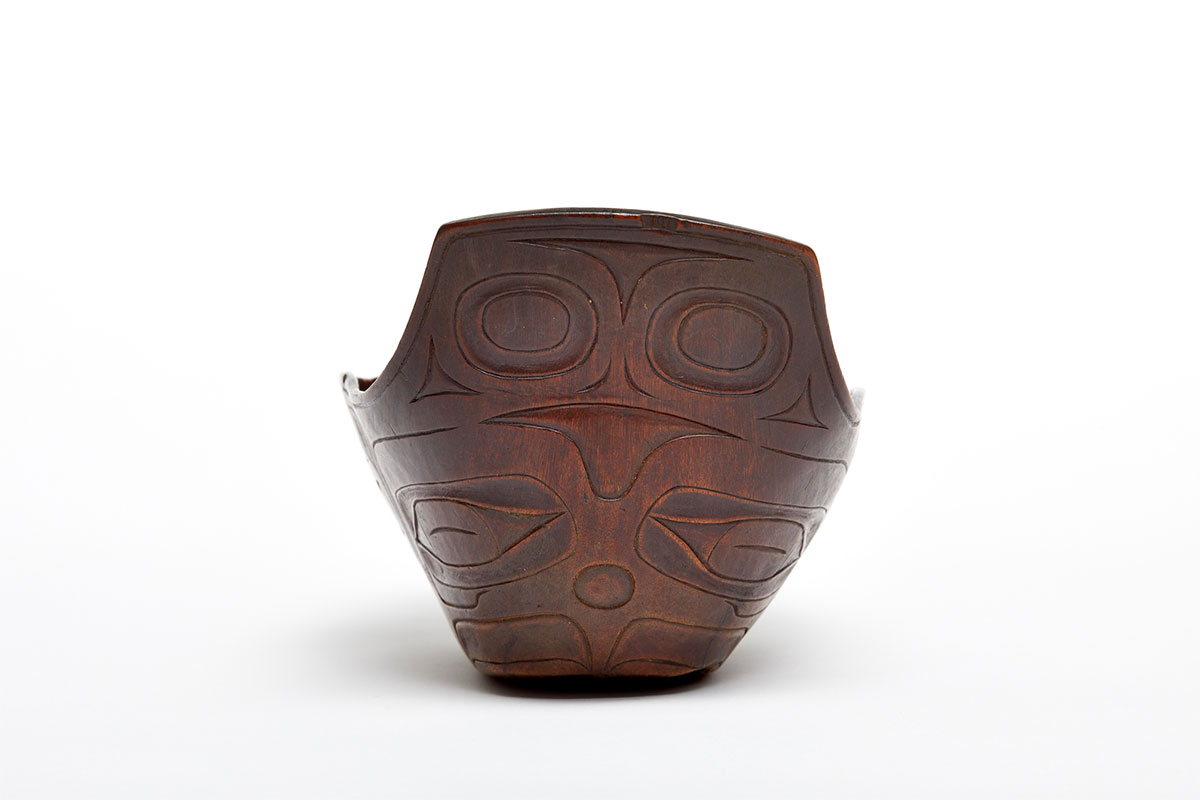Horn Bowl
Northern Northwest Coast
ca. 1800-1830
mountain sheep horn
width: 6"
Inventory # N4402
Sold
acquired by the National Gallery of Canada, Ottawa, ON
This sheep horn bowl displays a remarkable symmetry of design and is among only a small group of bowls from this early period of Northwest Coast carving (please see the attached full scholarly report by Steven C. Brown).
PROVENANCE
Private collection, United Kingdom
RELATED EXAMPLES
Staatliche Museen zu Berlin, Cat. No. IV A 1101 (digital archives, unpublished) for a bowl identified as Haida, collected by ethnographer Johan Adrian Jacobsen in the 1880’s, displaying the characteristic high ends and widely spaced formline designs typical of early period bowls
Donald Ellis Gallery, New York, NY, for another bowl of this early form displaying high rounded ends (ex. Charles and Valerie Diker Collection, New York, NY) – See: Donald Ellis Gallery, 2007, Toronto, pg. 47, identified as Haida
Staatliche Museen zu Berlin, Cat. No. IV A 1098 (digital archives, unpublished) for another early high-end bowl identified as Haida, collected by ethnographer Johan Adrian Jacobsen in the 1880’s
Spoons, ladles, and particularly bowls made from mountain sheep horn represent some of the most advanced technologies using natural materials that are known from the Northwest Coast. Made to be functional and beautiful, these ladles and bowls are for personal use and consumption of fish or seal oil, boiled fish or meat, created to be held comfortably in hand or lap.
Converting an extremely rough spiral horn of irregular thickness into a bilaterally symmetrical vessel is no simple task, but one at which Northwest Coast artists, including the maker of this example, exceled. The horn must be carved down to an even thickness by boiling to soften and open it up, shaping the ends of the bowl into one of several traditional types. This vessel represents an earlier type than others. Opening the inside of the horn’s curl gives access to the interior of the horn, where the material is smooth and almost plastic-like in the way it responds to hand tools. As the rough outside of the horn is carved away and thinned down, the form of the bowl takes shape. The last boiling opens the bowl much wider than the dimensions of the original horn, the ends rising higher and closer together than in the horn’s original curl. Final details of the pattern of grooves on the inside prepare the bowl for its exterior decoration.
The even thinness and symmetry of this bowl are remarkable, and not easy characteristics to attain. Pale when first carved, sheep horn slowly acquires a darker color through use and oxidation. The deep, rich patina on this bowl, however, is of a level that few have acquired, indicating exceptional age. The form of this bowl is an early northern type that echoes bowls made by interior Athabaskans, which were decorated with circle dots and other geometrical forms. Later bowl shapes came along and became the new norm in subsequent decades of the nineteenth century. This bowl was once somewhat wider, with the sides dipping down and bowing out farther instead of rising slightly in the middle. The bowl was carved with a nearly flat bottom for secure functionality.
The formlines that make up the faces on each end of the bowl are composed in an early style, made up of formlines and negative spaces proportioned in the manner of historical works from the pre-1840 period, going back as far as the first decades of the nineteenth century. The gracefully composed designs define a traditional form that is difficult if not impossible to identify as any specific creature, other than some sort of pointed-beak bird. Raven is of course a possibility, but not the only one. The formlines, though broad, nonetheless exhibit a smooth fluidity, much less blocky than those seen in some other early bowls of this type (see examples below). The formline compositions are related to the kinds of designs that appear on bent-corner boxes and chests, bent-corner bowls and carved bowls in wood (see examples below), which are somewhat generic in imagery, rather than representing the characteristics of specific crest images. This may be the case so that vessels and containers of these kinds can be traded or gifted across clan and tribal lines without violating traditions of crest ownership.
Steven C. Brown
December 2020











